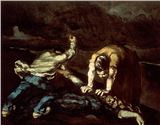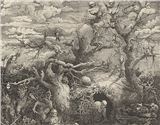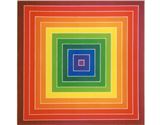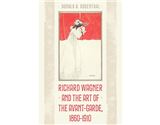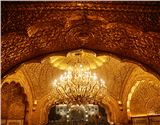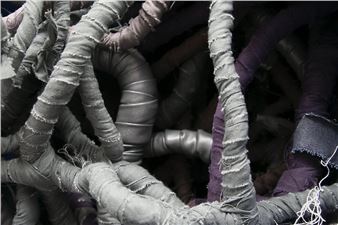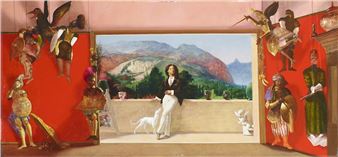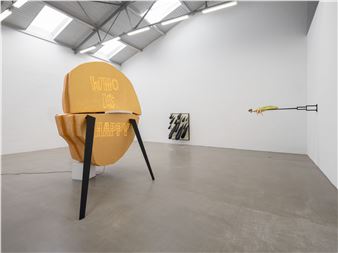Rémy Markowitsch: Schadenfreude
Galerie Eigen + Art, Leipzig
Leipzig | GermanyThe 1962 publication also attracted the bibliophile’s attention because the front cover was in perfect condition in contrast to the back cover, which had been severely damaged, probably by water. The mildew that formed in the resulting hole had penetrated practically the entire book, resulting in flaws and missing sections in the middle of the pages. Because of the irregularly shaped holes in the damaged pages, the reproductions show patches of the pages underneath so that two and sometimes three reproductions merge into a new visual whole.
One of the highlights of the 1962 auction was a collection of works by the Hungarian-Austrian painter Isidor Kaufmann (1853-1921). Kaufmann’s genre paintings are particularly important for their depiction of Jews, frequently Hasidic Jews, which he made while travelling through Eastern Europe. Along with artists like Moritz Daniel Oppenheim and Maurycy Gottlieb, Kaufmann devoted himself to studying the similarity of the Christian and Judaic worlds, particularly the way in which they developed under the influence of the Thora, religious symbols and beliefs. His paintings were also among the first to popularize these worlds. Data on key works by Kaufmann and other European Masters is complemented by black-and-white reproductions. For the hybrids created out of the large number of damaged pictures in the Fischer catalogue, Markowitsch chose motifs in which the fusion of the subject matter leads to a distinctive and often near-psychedelic dynamic. Hence, Kaufmann’s paintings play a dominant role in the 12-part portrait series Schadenfreude. Their fusion with the Christian iconography of works by other European Masters leads to a collision between two extremely heterogeneous, parallel realities. Markowitsch uses the cutting-edge digital technique of documentary photography to copy the varied visual idioms and subject matters he wishes to combine. These are then given a life of their own through digital transfer to Baryt paper. In this way he singles out the “landscapes of catastrophe” caused by the ravages of the elements. Serendipity has led to new visual substance.
Markowitsch has linked the 12 portraits in the Schadenfreude series with another work, Abraham, which is based on the back cover of the auction catalogue. The printed word "Abraham", which we see through several layers of tattered pages, is part of the caption for plate number 58, a painting of a battle at sea by the Netherlands artist Abraham Storck (1635- c. 1710). Markowitsch had the picture reproduced and framed on two strips of paper 180 cm tall -- the largest commercially available size -- making the overall measurements of the work 360 x 267 cm. This gives the parts of the catalogue, all the stained, torn, warped and differently printed scraps of paper, an extremely physical presence. When we gaze at these surfaces, it is like being a child again, lying on a blanket in a meadow or sitting in a baby seat in the car, and looking up at the sky. The visual associations that crowd in on us remind us of the figures, shapes and faces that we used to make out in the cloud formations. Within the context of Kaufmann's paintings, the name "Abraham" refers to the founding patriarch of the Israelites and the protagonist of the Tanakh, while the 12 portraits in theSchadenfreude series evoke the fathers of the 12 tribes of Israel. Gradually our attention is drawn to an arrangement of three dots that resembles the face of a puppy, with our brains interpreting scraps of paper and fragments of printing as eyes, body and paws. Once the image has formed in our minds, we can no longer ignore it. Crucially, the figure cannot be reconstructed as such because the extent of the damage makes the catalogue extremely fragile. Its pages are in constant movement and the configuration of the three little scraps of paper that create the impression of a puppy is a fortuitous coincidence, if not divine providence. But the meticulously processed documentary photograph lends permanence to the chance impression: it is artistic proof of divinity. By deliberately sharing the puppy's existence with us, Markowitsch imparts an infantile tenor to the pathos of the word, the name and the oversized format, what he himself calls a "triadic composition of daffiness”.

The 1962 publication also attracted the bibliophile’s attention because the front cover was in perfect condition in contrast to the back cover, which had been severely damaged, probably by water. The mildew that formed in the resulting hole had penetrated practically the entire book, resulting in flaws and missing sections in the middle of the pages. Because of the irregularly shaped holes in the damaged pages, the reproductions show patches of the pages underneath so that two and sometimes three reproductions merge into a new visual whole.
One of the highlights of the 1962 auction was a collection of works by the Hungarian-Austrian painter Isidor Kaufmann (1853-1921). Kaufmann’s genre paintings are particularly important for their depiction of Jews, frequently Hasidic Jews, which he made while travelling through Eastern Europe. Along with artists like Moritz Daniel Oppenheim and Maurycy Gottlieb, Kaufmann devoted himself to studying the similarity of the Christian and Judaic worlds, particularly the way in which they developed under the influence of the Thora, religious symbols and beliefs. His paintings were also among the first to popularize these worlds. Data on key works by Kaufmann and other European Masters is complemented by black-and-white reproductions. For the hybrids created out of the large number of damaged pictures in the Fischer catalogue, Markowitsch chose motifs in which the fusion of the subject matter leads to a distinctive and often near-psychedelic dynamic. Hence, Kaufmann’s paintings play a dominant role in the 12-part portrait series Schadenfreude. Their fusion with the Christian iconography of works by other European Masters leads to a collision between two extremely heterogeneous, parallel realities. Markowitsch uses the cutting-edge digital technique of documentary photography to copy the varied visual idioms and subject matters he wishes to combine. These are then given a life of their own through digital transfer to Baryt paper. In this way he singles out the “landscapes of catastrophe” caused by the ravages of the elements. Serendipity has led to new visual substance.
Markowitsch has linked the 12 portraits in the Schadenfreude series with another work, Abraham, which is based on the back cover of the auction catalogue. The printed word "Abraham", which we see through several layers of tattered pages, is part of the caption for plate number 58, a painting of a battle at sea by the Netherlands artist Abraham Storck (1635- c. 1710). Markowitsch had the picture reproduced and framed on two strips of paper 180 cm tall -- the largest commercially available size -- making the overall measurements of the work 360 x 267 cm. This gives the parts of the catalogue, all the stained, torn, warped and differently printed scraps of paper, an extremely physical presence. When we gaze at these surfaces, it is like being a child again, lying on a blanket in a meadow or sitting in a baby seat in the car, and looking up at the sky. The visual associations that crowd in on us remind us of the figures, shapes and faces that we used to make out in the cloud formations. Within the context of Kaufmann's paintings, the name "Abraham" refers to the founding patriarch of the Israelites and the protagonist of the Tanakh, while the 12 portraits in theSchadenfreude series evoke the fathers of the 12 tribes of Israel. Gradually our attention is drawn to an arrangement of three dots that resembles the face of a puppy, with our brains interpreting scraps of paper and fragments of printing as eyes, body and paws. Once the image has formed in our minds, we can no longer ignore it. Crucially, the figure cannot be reconstructed as such because the extent of the damage makes the catalogue extremely fragile. Its pages are in constant movement and the configuration of the three little scraps of paper that create the impression of a puppy is a fortuitous coincidence, if not divine providence. But the meticulously processed documentary photograph lends permanence to the chance impression: it is artistic proof of divinity. By deliberately sharing the puppy's existence with us, Markowitsch imparts an infantile tenor to the pathos of the word, the name and the oversized format, what he himself calls a "triadic composition of daffiness”.
Artists on show
Contact details



